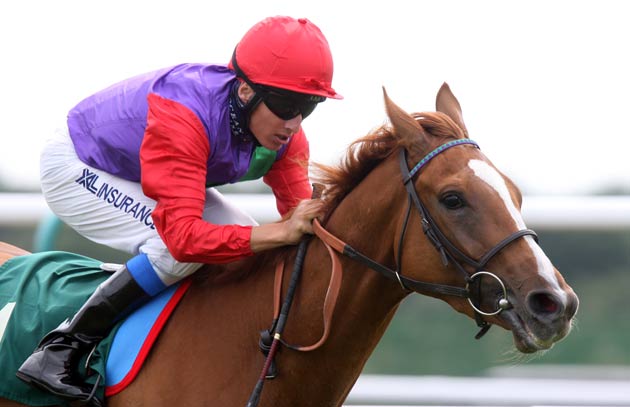Lure of the Sea shows sport thriving
Arc favourite's draw a sign of racing's rude health as shown in BHA's new report

You can take their word for it, or you can go to Longchamp on Sunday and see – and hear – for yourself. Yesterday the British Horseracing Authority (BHA) published a new study of the sport's economic impact, and was able once again to measure itself as "the second biggest sport in Britain after football".
To those beyond the sport, this claim comes as a perennial source of astonishment. Admittedly it traces its legitimacy to attendance figures that until recently ranked greyhound racing in third place – since overtaken by rugby union – and some of the underlying trends are less gratifying. But the bottom line is a wholesome level of interest in horse racing as live sport.
And this is by no means a bad week to emphasise quite how the British like to see horses in the flesh. For there always seem to be at least as many British (or Irish) accents as Parisian among the crowd at the Prix de l'Arc de Triomphe. Couch potatoes have two dedicated racing channels, and have historically enjoyed a luxurious terrestrial service as well – albeit the way the wind is blowing at the BBC is icily apparent from the fact that much of the Longchamp card this year retreats behind the red button. Regardless, the pulling power of a horse like Sea The Stars will narrow the Channel to a mere ditch for some 10,000 Britons.
Last year 5.7m people went racing in Britain, many to four events that reached the top eight in British sport, measured by attendance: Royal Ascot, the Cheltenham Festival, and the Derby and Grand National meetings.
The report, compiled by Deloitte, headlined various other reasons for racing to puff out its chest as "one of the country's best kept secrets", in the words of the BHA chief executive, Nic Coward. In 2008 the British Turf generated expenditure of £3.4bn, and contributed at least £325m in tax revenue. A core employment figure of 18,600 expands, through betting and other tangents, past 100,000. Moreover a parallel study, published simultaneously, disclosed a dynamic and outgoing sense of community, with over £1.8m raised through charity racedays.
At the same time, many of these indices have declined since this snapshot was taken, on the cusp of recession. Coward acknowledged that investment in ownership and bloodstock had come under strain, and that "things are likely to get worse before they get better". He duly reiterated a corresponding obligation in racing professionals to embrace and enhance the Racing For Change project.
Average attendances have actually plunged dramatically since 2003, from 4,934 to 4,029. But the fixture list has in the meantime been engorged as part of what is nowadays intended, at any rate, as a symbiotic relationship with the bookmakers. The fact that aggregate attendances have stagnated, despite this expansion, would imply saturation in the present audience – again, something to concentrate minds on Racing For Change. But many new fixtures have been tailored to the requirements of bookmakers, rather than racegoers, notably floodlit evening meetings in the winter.
Coward took the cue to reprise the lament that racing was not getting enough out of this relationship. "If further demonstration of our broken system were needed, we have the second highest betting turnover of the major racing nations yet the lowest return by far from the betting industry to our sport," he said.
Ironically, with their pari-mutuel monopoly, the French have a much better conduit between betting and racing. But they could not claim the same public connection and cannot be complacent in a betting environment so prone to rapid change.
Coward believes the focus must increasingly be on high days and holidays. Judging from the words yesterday of Michael Kinane, the veteran jockey charged with getting Sea The Stars home, Sunday will be one such. "He's in good shape," Kinane said. "He came out of his race at Leopardstown really well – he has actually got bigger and stronger."
A template, then, for the sport this colt bestrides: great already, but facing a significant new challenge, and so capable of proving better yet.
Turf account: Chris McGrath
*Nap
Sircozy (6.20 Kempton) Unexposed at middle distances and only just failed to catch a subsequent winner in a similar race here last time. The extra furlong could bring out improvement he scarcely needs.
*Next best
African Cheetah (5.30 Newcastle) Stuck in traffic when a close fourth at Folkestone last time. The way he has tended to grope for the next gear suggests this step up in distance will prompt him to show as much.
*One to watch
Swingkeel (J L Dunlop) remains an interesting candidate for the Totesport Cesarewitch despite finishing only third as a heavily backed favourite at Ascot on Sunday, his stamina entering the equation too late as a steady pace finally picked up.
*Where the money's going
Salute Him, trained by Tony Martin, is 10-1 from 12-1 with Sky Bet for the Totesport Cambridgeshire on Saturday and now shares favouritism with Sirvino and Charm School.
Subscribe to Independent Premium to bookmark this article
Want to bookmark your favourite articles and stories to read or reference later? Start your Independent Premium subscription today.

Join our commenting forum
Join thought-provoking conversations, follow other Independent readers and see their replies